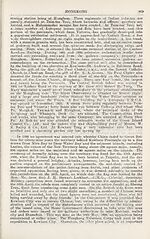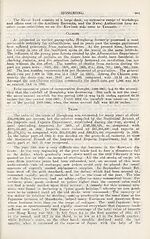1933
(1080) Page 980
Download files
Complete book:
Individual page:
Thumbnail gallery: Grid view | List view

980
HONGKONG
town on the river of the same name just beyond the boundary originally agreed!
upon. It was, however, restored to the Chinese authorities' in November, 1899.'
The New Territory under British jurisdiction is being rapidly developed by
the construction of roads; one of these, running from Kowloon to Castle Peak,
affording magnificent sea-scapes to the motorist, who Can return by way of'
Fan iLing and Taipo, the total distance being about sixty miles. Police stations
have been established, and a system of administration by means of village
communities organised. The headquarters of the administration are at Tai-
pohu. The railway from Kowloon to Canton, which passes through the New
Territory to Shamchun, has already done much to develop it. The Hongkong
Golf Club acquired an area of 55.62 acres in the valley stretching West from
Fanling and have converted it into a Golf Course of 18 holes, with two relief
Courses of 9 holes each, which are now being extended, the whole promising,
to be the best in the East. The neighbourhood and Taipo are coming into*
favour with Europeans for residental purposes by reason of the picturesque
scenery. The principal islands and their populations are as follows:—Lantao,
5,844; Cheung Chau, 5,035; Lamma, 1,256. These figures do not include the
floating population. The island® to the west of Hongkong contain 1,925; those-
to the east 1,169. The Chinese population of the New Territories is 95,503.
Of the islands and islets in ihe waters of the Colony (exclusive, of the above
acquisitions) the most important is Stonecutter’s Island, formerly known as
Wong Chune-chow, opposite to and about three-quarters of a mile from the
north-west extremity of the Kowloon peninsula. The island is an irregular
ridge about a mile in length, and a little over a quarter of a mile broad; the
principal eminences are occupied by batteries and no one is allowed to land
without a permit. The Quarantine Station also is. located here. After the
great typhoon of September, 1874, two or three thousand bodies of the victims
found afloat were interred on Stonecutter’s Island. K el let’s Island is a small
rock near East Point, on which formerly stood a fort, now replaced by a small
magazine. Gyeen Island, at the western entrance of the harbour, has been
planted with trees, and now justifies its name all the,^year round. A lighthouse
has been placed on its south-western extremity. One Tree;Island is a tiny rock
near the entrance to Aberdeen. Aplichau, a considerable island opposite
Aberdeen, of which harbour it forms part, has a populous fishing village on
its northern shore facing Aberdeen. Lantao and Lamma Islands were brought
under British jurisdiction by the Kowloon . Convention of 1898. The former
has a considerably larger area than Hongkong, but both this island and flLamma
are very sparsely populated by agriculturists and fishermen. Cheung Chau
is becoming popular as a summer resort for Europeans, numerous bungalows
having been erected in the European reservation by missionaries and others.
Population and iDefences
A census taken in April, 1931, showed the total population of the Colony
to be 852,932, as compared with 625,166 ten years ago. Kowloon, which had a
population of 74,698 in 1921 doubled its figures, while the Island inhabitants
have increased in numbers from 347,000 to 424,000, an increase of about 77,000.
The whole population may be summed up as follows:—City of Victoria, 424,522
(as compared with 347,401 in 1921); Kowloon, 262,899 (as compared with
123,488); New Territories, 95,503 (as compared with 83,163); and the floating
population, 69,008 (as compared with 71,154).
The Garrison consists of British and Indian, troops. There is also a local
Volunteer Defence Corps, The approaches to the harbour are strongly forti¬
fied, the batteries consisting of well-constructed, earthworks. The western
entrance is protected by guns on Mount Davis, Stonecutters Island and Belcher
Point. The Ly-ee-mim Pass is defended by forts on the Hongkong side and
another on Devil’s Teak on the mainland. The Colony of Hongkong pays to-
the British Government a military contribution fixed at 20 per cent, of the
revenue.
HONGKONG
town on the river of the same name just beyond the boundary originally agreed!
upon. It was, however, restored to the Chinese authorities' in November, 1899.'
The New Territory under British jurisdiction is being rapidly developed by
the construction of roads; one of these, running from Kowloon to Castle Peak,
affording magnificent sea-scapes to the motorist, who Can return by way of'
Fan iLing and Taipo, the total distance being about sixty miles. Police stations
have been established, and a system of administration by means of village
communities organised. The headquarters of the administration are at Tai-
pohu. The railway from Kowloon to Canton, which passes through the New
Territory to Shamchun, has already done much to develop it. The Hongkong
Golf Club acquired an area of 55.62 acres in the valley stretching West from
Fanling and have converted it into a Golf Course of 18 holes, with two relief
Courses of 9 holes each, which are now being extended, the whole promising,
to be the best in the East. The neighbourhood and Taipo are coming into*
favour with Europeans for residental purposes by reason of the picturesque
scenery. The principal islands and their populations are as follows:—Lantao,
5,844; Cheung Chau, 5,035; Lamma, 1,256. These figures do not include the
floating population. The island® to the west of Hongkong contain 1,925; those-
to the east 1,169. The Chinese population of the New Territories is 95,503.
Of the islands and islets in ihe waters of the Colony (exclusive, of the above
acquisitions) the most important is Stonecutter’s Island, formerly known as
Wong Chune-chow, opposite to and about three-quarters of a mile from the
north-west extremity of the Kowloon peninsula. The island is an irregular
ridge about a mile in length, and a little over a quarter of a mile broad; the
principal eminences are occupied by batteries and no one is allowed to land
without a permit. The Quarantine Station also is. located here. After the
great typhoon of September, 1874, two or three thousand bodies of the victims
found afloat were interred on Stonecutter’s Island. K el let’s Island is a small
rock near East Point, on which formerly stood a fort, now replaced by a small
magazine. Gyeen Island, at the western entrance of the harbour, has been
planted with trees, and now justifies its name all the,^year round. A lighthouse
has been placed on its south-western extremity. One Tree;Island is a tiny rock
near the entrance to Aberdeen. Aplichau, a considerable island opposite
Aberdeen, of which harbour it forms part, has a populous fishing village on
its northern shore facing Aberdeen. Lantao and Lamma Islands were brought
under British jurisdiction by the Kowloon . Convention of 1898. The former
has a considerably larger area than Hongkong, but both this island and flLamma
are very sparsely populated by agriculturists and fishermen. Cheung Chau
is becoming popular as a summer resort for Europeans, numerous bungalows
having been erected in the European reservation by missionaries and others.
Population and iDefences
A census taken in April, 1931, showed the total population of the Colony
to be 852,932, as compared with 625,166 ten years ago. Kowloon, which had a
population of 74,698 in 1921 doubled its figures, while the Island inhabitants
have increased in numbers from 347,000 to 424,000, an increase of about 77,000.
The whole population may be summed up as follows:—City of Victoria, 424,522
(as compared with 347,401 in 1921); Kowloon, 262,899 (as compared with
123,488); New Territories, 95,503 (as compared with 83,163); and the floating
population, 69,008 (as compared with 71,154).
The Garrison consists of British and Indian, troops. There is also a local
Volunteer Defence Corps, The approaches to the harbour are strongly forti¬
fied, the batteries consisting of well-constructed, earthworks. The western
entrance is protected by guns on Mount Davis, Stonecutters Island and Belcher
Point. The Ly-ee-mim Pass is defended by forts on the Hongkong side and
another on Devil’s Teak on the mainland. The Colony of Hongkong pays to-
the British Government a military contribution fixed at 20 per cent, of the
revenue.
Set display mode to:
![]() Universal Viewer |
Universal Viewer | ![]() Mirador |
Large image | Transcription
Mirador |
Large image | Transcription
Images and transcriptions on this page, including medium image downloads, may be used under the Creative Commons Attribution 4.0 International Licence unless otherwise stated. ![]()
| Asian directories and chronicles > 1933 > (1080) Page 980 |
|---|
| Permanent URL | https://digital.nls.uk/203688351 |
|---|
| Attribution and copyright: |
|
|---|---|
| Description | Volumes from the Asian 'Directory and Chronicle' series covering 1917-1941, but missing 1919 and 1923. Compiled annually from a multiplicity of local sources and research. They provide listings of each country's active corporations, foreign residents and government agencies of all nationalities for that year, together with their addresses. Content includes: various treaties; coverage of conflicts; currencies and taxes; consular fees; weights and measures; public holidays; festivals and traditions. A source of information for both Western states and communities of foreigners living in Asia. Published by Hongkong Daily Press. |
|---|---|
| Shelfmark | H3.86.1303 |
| Additional NLS resources: |

